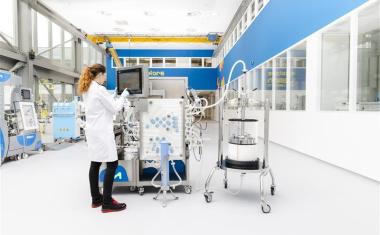Flow Chemistry
Executives and industry experts share their views on drivers as well as barriers for the use of flow chemistry in pharmaceutical manufacturing and the prospect for this technology in their industry sector.

Continuous manufacturing (CM) — also called flow chemistry or micro reaction technology (MRT) — is a technique that has been gaining global importance over the past decade as a result of improved process control and reduced operating costs, leading to increased manufacturing profits and a competitive edge. Recent years have shown that the reason for a company to change from “batch” to “flow” have been varied, often depending on the sector, process type of interest and scale of operation. Supply chain security and improvements in process sustainability are strong emerging drivers for the adoption of CM. Thus, it seems that flow chemistry is poised for a breakthrough as it is establishing as green, sustainable and profitable process technology.
With the product key, the infrastructure needed varies greatly and depends on the available chemistry, cost of goods, volumes required and the hazard profile of a transformation. The modularity and flexibility of continuous flow set-ups enables the development of small, agile production plants that can be used for the manufacture of multiple products — with easy re-configuration allowing for rapid product changeover.
Following on from this, the ease of replicating these small footprint systems represents an opportunity for manufacturers to develop a process and subsequently deliver production units across multiple countries to serve the local product demands. This is in stark contrast to the current approach of a single large-scale plant, with warehousing used to manage supply chain disruptions.
With all of these benefits, a logical question follows: Why the slow adoption of MRT?
CHEManager asked executives and industry experts to share their views on drivers as well as barriers for the use of flow chemistry and the prospect for this technology in their industry sector. We proposed to discuss the following aspects:
- In your opinion, what are the strongest drivers (success factors) of the implementation of flow chemistry processes?
- Which barriers are slowing down or impede the implementation of flow chemistry processes?
- What does it need for flow chemistry to be implemented more widely?
Read the insightful answers of the experts here.
Integral Part of CDMO Service Offerings
Ulrich Mayerhoeffer, Head Technical Evaluation and Development, Arxada
When discussing flow chemistry, we often hear buzzwords or phrases such as ‘faster and safer processes’, ‘ease of scalability’, and ‘improved quality’. Nevertheless, the CDMO space in pharmaceuticals and fine chemicals is still widely dominated by batch and semi-batch processes. At Arxada, we operate a variety of both semi-batch and flow processes within our multipurpose plants at our site in Visp.
Our technology selection is mainly driven by process safety, quality, sustainability, and overall economic considerations, with safety as the strongest driver towards a flow process. For us, flow chemistry facilitates the safe handling of thermally labile compounds, such as azides and nitro compounds. By minimizing the reaction volume, flow processes offer excellent heat exchange performance to control highly exothermic reactions. Within a cascading reaction set-up, the accumulation of explosive or hazardous intermediates can be minimized as they are directly telescoped and converted in the next stage of the process.
These advantages in terms of process parameter control are often also beneficial quality wise. The strengths of flow chemistry are clearly demonstrated in reactions where the control of side product formation or the control and preservation of stereo-information are vital. Other than in semi-batch mode, flow technologies allow processes to run in steady states at the ideal reaction conditions. As such, the characteristic properties of flow processing translate into an improved sustainability profile of the processes, as both heating and cooling of the reaction media are highly energy efficient, and improve atom economy.
At Arxada, we are strong believers in the benefits of flow chemistry. That’s why we are constantly investing in our technological development capabilities to facilitate the use of flow processing as an integral part of our CDMO service offerings.
Using Flow Chemistry to Explore the Potential of API Manufacturing
Jean-Baptiste Guillermin, Technical Sales Manager, Axplora
Flow chemistry has become increasingly important in API manufacturing over the last two decades, and even more recently, with the difficulties encountered in the supply chain during the Covid-19 crisis, and the necessity to accelerate time to market to answer patients’ needs.
Flow chemistry is particularly suitable for reactions with fast kinetics due to the increased heat and mass transfer characteristics of flow reactors. It is a very powerful technology for reactions requiring conditions difficult to meet with traditional batch reactors (e.g.: high temperature, high pressure) and opens the way to new chemical transformations with technologies that were previously complicated to scale-up (photochemistry or electrochemistry). It is also a great tool to better control the formation of unstable intermediates, increase selectivities, or produce highly energetic intermediates under safer conditions.
Thanks to increased performance of these reactors, continuous processing is often performed under higher concentration and milder temperature conditions, allowing a decreased energy consumption and decreased process mass intensity (PMI). Sustainability is a key metric to be taken into consideration from early development up to commercial manufacturing, therefore technologies allowing us to reduce the carbon footprint of chemical processes are extremely attractive.
Even if the pharmaceutical industry has been slow in implementing this technology, compared with other industries, continuous processing has been used for many years in this sector (e.g.: continuous chromatography – SMB), demonstrating its robustness at manufacturing scale. Given the widespread use of batch reactors, barriers for a wider adoption of this technology remain, but recent investments in this field will result in growing applications.
Axplora, created from the merger of Farmabios, Novasep and PharmaZell, is a reliable and agile partner, with 30 years of experience in continuous processing, able to evaluate and propose the most efficient solutions for the manufacturing of APIs.
Sustainability Is a Key Focus
Baburaj Krishnan, Head-CDMO, Drug Substance Development, Aurigene Pharmaceutical Services
Flow chemistry processes significantly increase productivity and process safety, but a strong driver is the aim to design more sustainable processes, which goes hand in hand with these aspects. Sustainability is also the key focus for large-scale API manufacturing. It can be achieved by combining the green chemistry principle and continuous processes. While green chemistry brings a better atom economy, continuous processes improve reaction selectivity and yield. Flow chemistry can significantly minimize the use of solvents, which usually contribute 50 % of the input mass in any batch manufacturing process. Integrating unit reactions and operations reduces the overall processing time and results in energy saving and high-throughput efficiency.
The technical capabilities in performing heterogeneous reactions and continuous crystallizations are an area to evolve. Batch processes provide flexibility for a wide range of reactions. Many homogenous and heterogeneous reactions can be performed in a single batch reactor without altering the equipment configuration. However, the flow process has particular limitations in accommodating different reactions in a single reactor.
Aurigene Pharmaceutical Services has a well-evolved methodology for establishing continuous processes. A recent example is a process that has been successfully developed and performed with continuous flow, which, otherwise, cannot be linearly scaled due to stability issues, its hazardous nature, and byproduct formation.
Opportunity to Explore Novel Process Windows
Srividya Ramakrishnan, Head, API Process Engineering, Dr. Reddy’s Laboratories
The strongest drivers are process safety, speed, cost, quality, and sustainability.
The enhanced mixing, mass and heat transfer in flow reactors, and the ability to precisely control the residence time and operate at extreme conditions provide an opportunity to explore novel process windows. Flow can boost reactions by running at temperatures and pressures considered unsafe in batch while significantly minimizing solvent usage. By controlling the residence time, the kinetics can be precisely optimized to increase the purity and decrease impurities.
The ability to intensify and handle hazardous reactions in flow significantly improves green chemistry metrics and reduces raw material costs, resulting in sustainable manufacturing at a lower price. With an effective control strategy, continuous manufacturing provides greater assurance on quality.
The biggest barriers are sunken capital and scarcity of talent. Considering the sunken capital into batch plants, any further investment into continuous may be difficult to rationalize based on return-on-investment alone. Hence, the benefits should be evaluated holistically to encourage adoption.
As this is an evolving technology, experienced talent is scarce and few undergraduate chemistry curriculums include flow chemistry.
At Dr. Reddy’s, we utilize flow chemistry for hazardous and cryogenic reactions, which are safer in flow and with lower operating expenses. We are also in the process of commissioning a modular plant for an intermediate to API process encompassing multiple reactions and unit operations. The driver to adopt this is a move towards sustainable manufacturing with improved green metrics, lower operating costs, and minimal manual operations. All this helps us in our mission to accelerate access to high quality and affordable medicines.
Flow Chemistry: Some Precautions to Take but also Many Advantages
Kai Rossen, Chief Scientific Officer, Euroapi
The synthesis of organic compounds is a science that is practiced for the last good 150 years, but the last 20 years have seen a re-discovery of flow chemistry, which is a deviation from the classical batch process. The classical batch process works well, but there are many types of reactions and reaction conditions that simply cannot be performed in batch. These would be ignored in an optimization and are thus highly limiting. The application of flow chemistry is thus a critical tool in finding the optimum for the synthesis of a compound, such as an API.
Continuous reactions can give access to higher temperatures and pressure, enabling more efficient synthesis routes and the process can generate less hazardous substances and toxic releases. Regarding highly potent active pharmaceutical ingredients, it can also reduce cross-contamination and cleaning needs.
It is nevertheless mandatory to be objective – simply putting a poorly designed reaction into a flow reactor is simply false advertisement. There is no doubt that processes that cleverly combine the potential of continuous processes into the design are extremely powerful and enabling. An example from Euroapi is our continuous production of Sevelamer, where the holistic design of a process is now enabling the continuous production without the use of a solvent. This is a very good example that highlights the powerful potential of a flow reaction when excellent understanding of the underlying chemistry is combined with creative engineering.
This development is enabled by open communication between the different disciplines of science, something that is helped when organic chemists have at least a basic knowledge of chemical engineering, just as chemical engineers are trained in organic chemistry. It is very good to see that the coming generation of scientists have this training and one can expect that the new generation will discover even more opportunities leading to better processes to produce API.
Providing the Value of Flow Chemistry wherever Possible
Stephen D. Drake, Director of Marketing and Development, Kaneka Americas Holdings
Since 2017 Kaneka has been invested in developing commercial manufacturing approaches using flow chemistry and we currently have an FDA inspected GMP intermediate process using flow to produce ~3 MT/year of an intermediate through phosgenation. Our reactors at Kaneka are designed in house and customizable to many types of chemistry to produce RSMs, intermediates, and APIs at the pilot and commercial scale with a relatively seamless scale up from the laboratory. This is an area we continuously invest in with our customers to provide the value of flow chemistry wherever possible.
Our strongest drivers to use this technology are focused on giving the best chemistry to our customers with access to difficult chemistry in batch, or to provide some monetary or safety benefits as well.
The biggest barrier we see to using this technology is the customer buy-in, unfortunately. There is a large interest in discovery to evaluate this technology, but it often is decided by our customers to not be implemented at production scale, for various reasons unrelated to our capability.
Complementary Technology to Batch Manufacturing
Mark Muldowney, Head of Technology & Innovation, Sterling Pharma Solutions
It is important to remember that flow chemistry is not a ‘one size fits all’ technology for chemical manufacturing, and not every process will be relevant for flow chemistry at commercial scale. However, one of the greatest benefits it offers is through safety when handling highly potent and hazardous or highly reactive species, as it reduces the risk of exposure to operators and scientists by having smaller quantities of materials within the reaction vessel at any one time.
The technology broadens the toolkit for development chemists and should be seen very much as complementary to batch manufacturing, rather than a replacement. Its use allows the variation and control of scale-up conditions for manufacturing and provides access to new chemical reaction space through higher temperatures, pressures, concentration, and kinetics. From a process control and material quality standpoint, developing a flow reactor and specific reaction parameters that can be constantly monitored and adjusted within a defined range can ensure a more consistent product specification.
Flow synthesis also generates new development opportunities based upon utilizing biocatalysis and heterogenous catalysts, as well as electrochemical oxidation and reduction, where the technology could be advantageous to improve not only chemical selectivity and quality, but also to avoid exposure to toxic intermediates. Additionally, photochemistry lends itself perfectly to flow chemistry, where there is a move away from traditional routes that use metal catalysts, and opens up new methodologies that are cleaner, more energy efficient and cheaper to run at scale.
Using flow chemistry also allows the design of potentially integrated multi-step chemical synthesis, where continuous synthesis, work-up and purification (e.g., crystallization or distillation) can be linked with tasks such as drying, milling and formulation in an efficient work pattern.
Efficient Preparation of High-quality Pharmaceutical Ingredients
Shawn Walker, SVP Development of Operations & CTO, Veranova
Although the pharmaceutical industry has historically relied on batch or semi-batch manufacturing processes for pharmaceutical ingredients, there is growing awareness of the benefits of continuous manufacturing using flow chemistry. These benefits include enhanced process safety through the more efficient removal of heat in flow processes compared to batch manufacturing, the ability to produce and rapidly react unstable or short half-life intermediates, as well as improving access to chemistry that has been historically challenging to scale-up in batch, such as photochemistry, electrochemistry, and high temperature/pressure processes.
In addition, small volume continuous manufacturing provides the flexibility of using a modular equipment footprint, where individual unit operations (including reaction, work-up extraction/distillation, and product crystallization) can be conducted on portable skids. This cost-efficient approach requires less manufacturing space, minimizes downtime due to equipment turnover, and supports like-for-like tech transfer, as the same equipment used for process development can be assembled or shipped for manufacturing.
Manufacturing with flow chemistry is also more amenable to the use of process analytical technology (PAT) tools to increase process control, reduce variability, and assure product quality. Looking to the future, the application of machine learning tools and artificial intelligence should also aid the development of self-optimizing reaction systems and automated process characterization based on modulating flow chemistry parameters such as temperature, feed rate, residence time etc.
In summary, due to the advantages highlighted above, global health authorities as well as the pharmaceutical industry and their partner (CDMO) organizations are increasingly looking to implement flow chemistry processes for the efficient preparation of high-quality pharmaceutical ingredients.
Flow Chemistry has no real Showstoppers
Christophe Girard, Process Engineer, Siegfried
lmplementing flow chemistry has several advantages compared with batch chemistry. Firstly, safety is improved because there is less danger from exothermic reactions or toxic substances due to smaller reaction volumes. The yield and purity can be increased, because of more precise control over reaction variables such as mass and heat transfer. Additionally, sustainability is improved, attributable to lower solvent consumption and energy use - and thus a reduced carbon footprint. Lastly, capital expenditures for new investments are also reduced because compact modular process skids enable one to perform different flow processes within a small area.
The main challenge of flow chemistry is highly heterogeneous reactions, which can clog the reaction system. Furthermore, the relatively small number of batches and the challenges of batch traceability has hindered acceptance in pharma manufacturing - yet these regulatory issues are being resolved. Although it is often easier to produce the first kilograms in batch mode, multidisciplinary teams can readily take advantage of the benefits of flow chemistry. Therefore, flow chemistry has no real "show-stoppers."
Siegfried will use flow chemistry for reactions that are difficult to control or too hazardous to perform with standard batch equipment, for example, high temperature, pressure or oxidation. We will combine flow chemistry with continuous downstream processing such as extraction and distillation to drive maximum process stability, product quality, and yield.


















